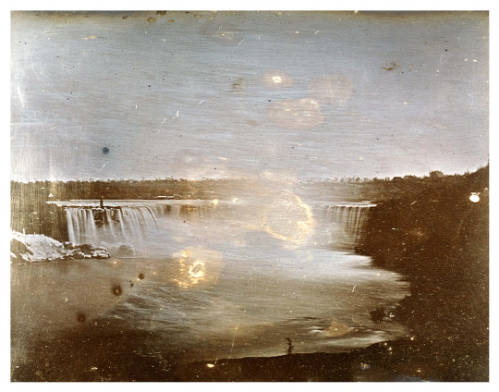The First Photograph of Canada was Taken by a Man from Newcastle


The Horseshoe Falls, 1840. Licensed by Newcastle University under CC by 4.0
It’s all connected. You only have to take notice of the coincidences, the tiny ripples in space and time, to know seemingly unrelated events are connected.
There are a few stories for how Canada got its name but the one that stuck for me involves the Spanish. It was the mid-16th century when the first Spaniards set foot on the east coast of Canada and proclaimed, “aca nada!”, “nothing here!”
The Spanish named the land they visited via the St Lawrence River “Capa de Nada”, “Cape Nothing”. By the time French and British settled their 13 colonies in the early 17th century, the name had stuck. Capa de Nada. Canada.
I thought I read this in one of my favourite books, A Field Guide to Getting Lost by Rebecca Solnit. I re-read the book recently, hoping to find her take on this tale but couldn’t find it. I’ve lost the reference. But in thinking about Canada I found something else.
Did you know that the first photograph taken of Canada was taken by a man from Newcastle Upon Tyne? I’m from Newcastle Upon Tyne and returned to my home city last summer after living in Canada for two years. I work in the university library now and miss Canada badly. Clicking through the library’s special collections page one morning, looking for nothing, I found something amazing.
I’ve been there, I thought.




These images are of Niagara Falls, one of the most visited tourist attractions in Canada yet despite living in Toronto, only a 2 hour, 20 minute drive from the falls, I didn’t go until almost a year into my stay. I reasoned that it wasn’t going anywhere.
The photographer is a man named Hugh Lee Pattinson, not a name you’re likely to know unless you’re interested in the industrial history of Newcastle Upon Tyne. Which I am. Hugh travelled to Canada on business around 1840. While there, acting like the tourist he was, he used his new camera to take a snap of Niagara Falls.
The camera was new in two senses, new to Pattinson, but also new to the world having been invented in 1839, only one year earlier. Anyone who’s been to Niagara Falls has taken photographs but none in the exact same spot Hugh did. There was no promenade in 1840, no Hornblower or Maid of the Mist, no selfie sticks.
Hugh’s selfie stick was a light box fitted with a silver-plated copper plate. The daguerreotype process took around 20 minutes. Time for the image to burn itself into the copper plate and and for mercury fumes to entice it into visibility. Time too for the photographer to put himself into the frame.
Probably unknown to Hugh, his photograph (the one at the top of this post) is not only the first taken of Niagara Falls, but it is also quite likely the first photograph taken of Canada. Proto-Canada, I suppose, as this land would not officially become Canada until 37 years later.
And isn’t that what anyone who takes photographs really wants? To capture something never seen before and create an image that’s so pure that it becomes more real than the real thing. I prefer the Niagara Hugh saw but that’s gone now, it’ll never be a wild place again.
At least we have a record of what Hugh saw, stored in Newcastle University’s special collections department. You can’t look at it. I already asked. It’s so fragile that even exposure to the air could damage its delicate surface.
But as I clicked and enlarged a digitised image, the original daguerreotype Hugh made with his own hands was right there in the special collections’ storage space beneath my feet.
It’s all connected.

Licensed by Newcastle University under CC by 4.0
